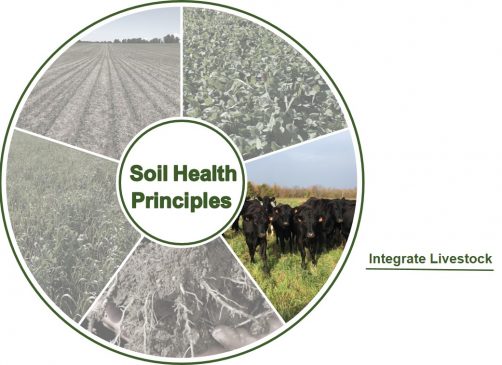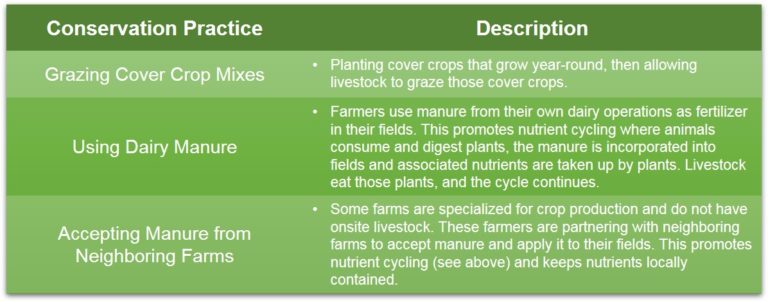Integrate Livestock
Image Credit: Lacey Olson for UW-Extension
Integrate Livestock
This principle refers to incorporating livestock into the farming system in a way that crops and livestock complement one another.
(NRCS – Integrate Crops and Livestock)

Importance
In natural systems animals, plants, and soils are intertwined. Animals graze plants, then produce fertilizer in the form of manure. The plants uptake nutrients from the fertilizer and in turn produce soil exudates and soil organic matter. The healthy soil then supports continued plant growth, which are grazed by animals, and the cycle continues.
However, agriculture over the past half-century has separated animal and crop systems, leading to a breakdown of these important and intertwined relationships.
Integrating livestock into crop production systems can:
- Reduce External Inputs – Livestock supply fertilizer in the form of manure, thus requiring fewer external inputs into the cropping system.
- Balance Carbon/Nitrogen Ratio – Fall or winter grazing converts high carbon annual crop residue to low carbon organic material, balancing the carbon/nitrogen ratio in the soil and managing crop residue for no-till seeding.
- Support Plant Growth – Grazing plants in spring or summer, using short exposure periods followed by long recovery periods, allows the plants to regrow and harvest additional sunlight and CO2.
- Reduce Nutrient Export – Instead of transporting feed to a feed lot, livestock can graze the material in place. This recycles the majority of nutrients, minerals, vitamins, and carbon and keeps them within the system.
- Reduce Animal Feeding Costs – Animals can graze living plants, reducing the amount of feed that must be purchased.
- Reduce Livestock Waste Concentration – Grazing reduces livestock waste associated with confinement by dispersing the waste directly onto the pasture and allowing its nutrients to be taken up by the plants the livestock are feeding on. This in turn helps improve water quality by managing nutrients efficiently.
- Provide Weed Management – Livestock can suppress weeds by foraging on them.
- IMPROVE SOIL HEALTH!
- (NRCS – Livestock Integration)
Cattle grazing a multi-species cover crop mix. The cover crop is improving the soil health and benefitting the cattle as they can graze this field, especially in August when the regular pasture productivity drops.
Image Credit: Derrick Raspor
- Balance Carbon/Nitrogen Ratio – Fall or winter grazing converts high carbon annual crop residue to low carbon organic material, balancing the carbon/nitrogen ratio in the soil and managing crop residue for no-till seeding.
- Support Plant Growth – Grazing plants in spring or summer, using short exposure periods followed by long recovery periods, allows the plants to regrow and harvest additional sunlight and CO2.
- Reduce Nutrient Export – Instead of transporting feed to a feed lot, livestock can graze the material in place. This recycles the majority of nutrients, minerals, vitamins, and carbon and keeps them within the system.
- Reduce Animal Feeding Costs – Animals can graze living plants, reducing the amount of feed that must be purchased.
- Reduce Livestock Waste Concentration – Grazing reduces livestock waste associated with confinement by dispersing the waste directly onto the pasture and allowing its nutrients to be taken up by the plants the livestock are feeding on. This in turn helps improve water quality by managing nutrients efficiently.
- Provide Weed Management – Livestock can suppress weeds by foraging on them.
- IMPROVE SOIL HEALTH!
Our Farmers at Work
Our Farmers at Work
The Between the Lakes Demonstration Farm Network farmers are working to integrate livestock into their operations.
The Between the Lakes Demonstration Farm Network farmers are working to integrate livestock into their operations. Learn how they do this in the chart below.
To do this, they use

